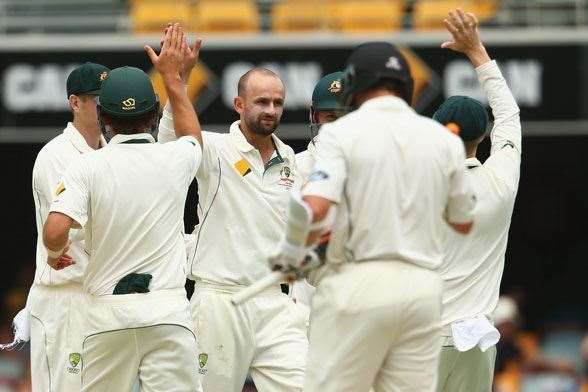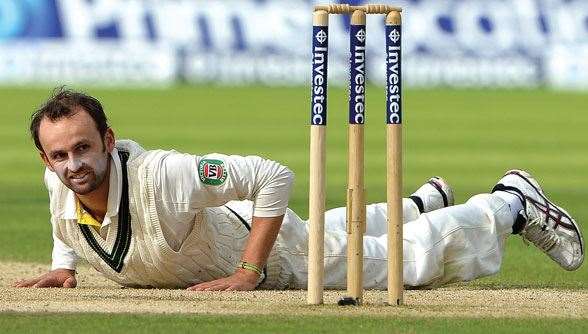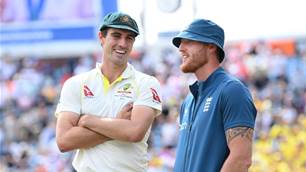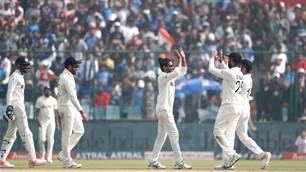He's the most prolific finger spinner in Aussie cricket history.
The most prolific finger spinner in the history of Australian cricket may not look or act the part, but he’s becoming a mainstay for his country in the test arena. Not many saw that coming …
Nathan Lyon, GOAT. Not as in scape, but the all-upper case kind. Not some afterthought turner, included to give the attack some vague notion of “variety”. Not a stopgap to be replaced at the first hint of a positional upgrade. Not even a yeah-he’s-pretty-good member of the Test side. GOAT. Greatest Of All Time.
When Lyon knocked over West Indian opener Kraigg Brathwaite’s off stump in the Jamaica Test last June, he’d done something no other Australian off-spin bowler ever had – take 142 Test wickets. Lyon had surpassed the heretofore most prolific finger spinner to wear the baggy green, Hugh Trumble, whose mark of 141 in 32 matches had endured since 1904. Outside the circle of history buffs and stat geeks, Lyon’s feat came as a surprise. Forget breaking the national record for his class of bowler; the fact that he was closing in on Australia’s top 20 wicket-takers all time was a bit of a shock. But as any good spinner does to an unsuspecting opponent at the crease, Lyon had snuck up on all of us.
It is kind of funny to attach the GOAT tag to Lyon, which is probably the reason why his team-mates were so quick to do it. Conventionally, Australian sides have been distinguished by the attacking, bouncy leg-spinner; offies not so much, which stands to reason why Trumble’s record lasted as long as it did. But there was more to it than defying classical norms. As he was once described in The Guardian newspaper during the competitive fever of an Ashes series, Lyon didn’t much look like a modern cricketer and even less a professional athlete: “It seems as if Lyon almost cultivates his hangdog air.” And this was a set of compliments, mind you. Where Shane Warne brought an intimidating, fast-bowler attitude to his spin bowling, Lyon works an entirely different angle – underestimate at your own risk.
It neatly accords with Lyon’s personality. Self-effacing and quietly spoken, he’s the dictionary definition of unassuming. The kind of character you find out in the country, which is surely where Nathan Lyon hails from. Uncomplicated: plays his cricket, takes it easy, goes out to play again. When Inside Sport catches up with him, it’s a quiet moment less than 24 hours out from the first day of a Test match against New Zealand. “It is just about trying to keep things as simple as possible,” he says of his day-before routine. “I know Mitch Starc tends to bring away his PlayStation, so a few of the boys float in and out of his room at the hotel to have a game of FIFA.”
For sportsmen the world over, video-game football is the new cards. “It is good fun; provides a bit of banter,” Lyon continues, admitting it’s not something he’s well-versed in. “No video games where I was growing up out in Young. Myself and my brother and I were outside playing cricket. I’m good mates with Mitch Starc, so I tend to be in his room a fair bit. I have been converted, I have to say. I tend to go for the best team, Real Madrid. I need all the help.”

It’s show business lore that Lana Turner was discovered at the counter of an ice cream parlour in Hollywood. The moral of that story: if you want to be a movie star, hang around where the movie stars are found.
The origin tale of Nathan Lyon has a similar, although less-glamorous, bent: the groundskeeper who became a Test spinner. If it were fable, Lyon had left rural NSW to work the grounds at Adelaide Oval. During a lunch break in the nets, then-South Australian coach Darren Berry tossed the ball to the guy mowing the grass, who bowled a useful off-break. The Redbacks suddenly found they had a quality spinner on their hands, and little more than six months after making his first-class debut he had made it into the Australian side.
The groundskeeper thing has stuck to Lyon, one of those bio details that seems to explain a hell of a lot. But when it gives the impression that he happened upon his sporting career by accident, fable trips over into falsehood. Lyon moved from Young (cherry capital of Australia) to nearby Canberra (the actual capital of Australia) to pursue his cricket, and the curating followed.
“I was pretty lucky, really,” he says. “I was unemployed for two days before ACT Cricket contacted me and said they’ve got an apprenticeship here if I wanted it. While at school, I probably didn’t study hard enough and I didn’t want to go to uni or anything like that. I called my Dad and said there’s an opportunity for a curating apprenticeship. And he said, ‘Go for it, you’ve got no income at the moment, so you might as well learn a trade.’ From day one, I fell in love with the job. You’re outside every day, and if it rains, you go home.”
Lyon tended to Manuka Oval, played club cricket and moved up the ACT’s representative ranks. It was in those circles he met Mark Higgs, another capital region product who played for NSW and South Australia. A left-arm spinning all-rounder, he is probably best known as the surprise replacement for an injured Shane Warne in the Australian team competing in the ICC Knock-Out Trophy in Kenya in 2000.
“Mark Higgs played a vital role for me moving from a country town into what I thought was a big city in Canberra,” Lyon says. “He took me under his wing with spin bowling; really taught me the ropes at a young age. He had a pretty good first-class career, and he passed along the knowledge, which was fantastic for me being between the ages of 17-18 up to 22.”
Higgs remembers a shy, young man with a hint of irreverence. “Playing against him [in club cricket], he tried to wind me up a few times,” Higgs says. “I was usually a heavy sledger, and he had ways around that. For a young person to do that, he was quite clever the way he went about it ... It was an attitude, just a bit of a cheeky smile.”
The talent was there – a nice, high action, the ability to generate uncommon bounce while still getting drop and overspin – but Higgs says the difference was the capacity for improvement, and a willingness to listen. This quality has been double-edged for Lyon – for whatever reason, everyone in and around the game seems to have a piece of advice to offer spinners, and filtering it all can be trying. “For Lyonsy in particular, it took a bit of work to get him to the spin camps and all those sort of showings,” Higgs says.
“Early on in his career, he was subject to a lot of advice because he didn’t get the pathway that you see in some other cricketers. He was still nervous about his game and still developing his confidence, as much as his bowling technique. Once he found Davo [Australian spin coach John Davison] up there, someone he could talk to consistently, that helped him along.”
The ACT used to field a team in domestic under-23 comps, and it was in the T20 Baby Bash event in Melbourne in 2010 that a crucial career turn opened up in a game against South Australia. The SA senior coach, Berry, was watching that day. “It just so happened that the South Australian team opened with three lefties,” says Higgs, the ACT captain. “Traditionally, I had a left-arm ortho who opened the bowling, but with the lefties coming out, I threw the ball to Lyonsy. It was a circumstantial thing, and he’s always been able to bowl well to the lefties, because he’s effective around the wicket. He bowled brilliantly.
“From there, we were in contact with SACA about an opportunity over there. I was conscious of the fact that Lyonsy had to go to Sydney or Adelaide, because of the turn in the state wicket. If you’re going to effectively develop a spinner, you can only do it in two states, really.”
Lyon had also been in touch with another old Canberra contact, former Comets coach Ashley Ross, who was working in SA cricket. The offer to move interstate did include a job as assistant curator at Adelaide Oval, but the state side was also after an off-spinner. “My ultimate goal was to play cricket for Australia, and that’s the main reason I moved down to Adelaide,” Lyon says. “I know it was reported that I moved down there to chase my curating dream ... but they contacted me, wanting an off-spinner.
“If cricket didn’t work out, I definitely would still be in the curating game. Being a curator is the closest thing, maybe not to playing international cricket, but if you’re lucky enough to work on Manuka Oval or Adelaide Oval, you’re surrounded by international cricket stars.”
 (Photo by Getty Images)
(Photo by Getty Images)
Nathan Lyon would soon find himself surrounded by world-class cricketers alright. With only four Sheffield Shield matches under his belt, the then-23-year-old was selected in the Australia side to tour Sri Lanka in August 2011. To label his call-up a surprise was a massive understatement – Cameron White, then the national T20 captain, described selection policy at the time as “open door”. Coincidentally, one of the players dropped from the side as Lyon made his way in was Steve Smith.
Reeling in the aftermath of a home Ashes series loss, Australian cricket was going through a highly self-conscious period as the Argus Review of the national team’s performance was about to land. Another Cricket Australia study that year had looked at how the nation’s spin-bowling capability had declined since the departure of Warne from the side in 2007. The plain record told the story: 11 different spinners had been tried, with names such as Casson, Krejza, McGain, Doherty and Beer passing through the turnstile.
The study was unambiguous about the problem: spinners weren’t putting in enough time to develop their craft, and the conditions around them weren’t conducive to doing so. Spinners needed the opportunity to bowl more, but their critical development period only began when their junior cricket career ended and the chances of getting a game narrowed. The study took it further; the distraction-filled modern lifestyle, with computer games and television, was preventing kids from giving it a rip in the backyard.
If the study could have posited a model prospect, it might have come up with the part-time curator from Young. “Spot on,” Lyon says. “Spinners mature quite late, and these days, the average age of making a first-class debut in cricket around Australia is quite young. The spinners may get lost a bit and fall out of the system. But it’s about having the hard work and self-belief, the determination that if you want to have a crack, have a full-tilt crack.”
Lyon describes his beginnings as an off-spinner as that most elemental of cricketing impulses – whatever you have to do when playing against your big brother in the backyard, in his case Brendan, who is three years older. The ground out back was sloped, and Brendan would turn leggies down the hill. “I wasn’t big enough to bowl leg spin and turn it back up the hill to him, and I had to figure out how to actually get the ball to him. So that’s how I got into off spin,” Lyon says. “I’ve always had the competitive bone in my body, having an older brother and playing backyard cricket against him.”
Lyon made his debut in the baggy green in Sri Lanka and, auspiciously, took a wicket with his first delivery. Kumar Sangakkara, no less, edging to slip. He remained the first-choice spinner through the summer, and reached 50 Test wickets in one fewer match than Warne. Observers were impressed, among them former Australian off-spinner Ashley Mallett, who wrote: “I have no hesitation in saying that you are the best Australian offie I’ve seen in nearly 30 years.”
The early returns were good, but whether it was that unimposing countenance, or the lack of a signature, match-winning performance, or just the overhang of Warne in the fans’ memory, Lyon wasn’t regarded as an untouchable in the side. He retained his spot through the summer of 2012-13, but the impression that stuck was the inability of the Australian attack to knock over the stonewalling South Africans in the last day and a half of the Adelaide Test. In a situation where a spinner is counted upon to exploit the conditions, Lyon bowled 50 overs in that last innings, but couldn’t get his team past the Faf du Plessis-led rearguard.
On the following tour to India, Lyon was dropped after the first Test, with then-coach Mickey Arthur giving him a backhanded vote of confidence – Arthur still had faith in Lyon, he just hadn’t played well all summer. Lyon’s form was the least of Arthur’s problems on that tour, as the team became engulfed by the Homework-gate scandal. The turmoil saw Lyon return to the side, and he performed well in the last Test, taking seven wickets in the Indian first innings, but the dispirited Australians were crashing to a 4-0 series defeat. The state of flux in the Test XI carried through to the Ashes in England four months later. At the start of the series, Lyon was left out again, with Ashton Agar famously preferred for the first match in Trent Bridge.
Spin bowling has a historic reputation for attracting eccentrics to its ranks, be they flamboyant gamblers like Warne, buttoned-down ciphers such as Sonny Ramadhin, or the downright weird assortment of English left-armers over the years. The vocation itself is so evidently unusual that it could be reasonably asked whether it’s a case of self-selection: would only an eccentric choose to lob slow-moving question-marks at a batsman?
Lyon comes off as normal by spinner standard – his mate and mentor in the Australian side, Mike Hussey, attests to that. But he does possess the one other trait that the class of odd-bowling oddballs shares: a pliable kind of resilience, able to withstand those days when the batsmen are flaying you to all parts of the ground. “It’s a tough art; you need to have a thick skin to bowl spin at the top level,” Hussey says. “He’s got that, and I’m sure he’s gone through some tough times as well, where things haven’t gone his way. But that’s the thing, he’s very resilient; he always bounces back.”
Lyon would prove it in the 2013 Ashes series. He replaced Agar in the third Test in Manchester, only to run into a mauling from Kevin Pietersen. But he had bowled well overall, and on the first day of the fourth Test he cleaned up the English middle order, including the vengeance wicket of Pietersen.
Lyon’s confidante, Davison, later said he had indeed gone through a slump in the months beforehand. “But in hindsight, it was a really positive time for us because we had a chance to go back and work out what he did well,” Davison told the Cricket Australia website. Lyon has established himself as a consistent performer since, and overcame the can’t-close knock against India in Adelaide – in an emotionally-charged Test after the death of Phil Hughes, Lyon took 12 wickets, seven of them in India’s second innings, to lead Australia to the win.
“Yeah, you’re going to have good days and you’re going to have bad days,” Lyon says. “It’s how you respond to the bad days. It’s about getting knocked off your feet and getting back up there. Challenging yourself every day – I go out to training each and every day to get better. The day I stop trying to get better is the day I’ll give up the game at the highest level.
“The big thing is believing in yourself. You are obviously there for a reason, and you’re playing cricket against the best players in the world, so why wouldn’t you want to challenge yourself and see how far you would go? The sky’s the limit; you may not reach it, but you might pick off a fair few goals trying to reach it. The big thing for me is challenging yourself. It is the way you bounce back from not having a great day.”
 (Photo by Getty Images)
(Photo by Getty Images)
The most recent Ashes series was another set of bad days. Lyon hasn’t gotten over it: “The biggest disappointment, I still believe, is if we played our best cricket out there, England wouldn’t have come close to us. But we didn’t play our best cricket, and England probably did.
“We weren’t consistent enough in each area of the game, we struggled to put together partnerships with the bat and we definitely didn’t bowl in partnerships with the ball. That’s where Australia’s biggest strengths are when we are playing well, we’re doing stuff together.”
In this post-Ashes period of transition for the Australian team, Lyon has emerged as a key figure. With Mitchell Johnson’s retirement, Lyon stands as the most-capped player of the remaining regulars. And while the leadership positions went to Smith and Warner, Lyon is being counted upon to be a staple of Aussie dressing-rooms throughout time – the baggy green stalwart, the bloke totally smitten with the idea of playing for Australia.
Mike Hussey was archetypal in filling this role, and he immediately saw it in Lyon when he first arrived in the team. Hussey volunteered to take on Lyon in a newly installed buddy system, and the two bonded. When Hussey retired in 2013, he bequeathed the leading of Under the Southern Cross I Stand – more or less the official marker of the baggy green spirit-leader – to Lyon. “I like him as a player, he’s a very good bowler,” Hussey says. “But he’s a good character as well; he plays for the right reasons. He respects the game and the past players, and he wants to be part of a good team. He wants to do individually well, but he gets a lot of pleasure out of team-mates doing well. He’s got some fantastic character traits.”
Lyon hopes to pay it forward. “I was extremely lucky to have Mike Hussey as a mentor. To this day, we still talk a fair bit, and he’s always there if I need to ask a question, even now. It is important to me to carry on what the older guys did for me. Hopefully I can provide a bit of assistance here and there for a couple of the younger guys. I know Mitch Marsh is an unbelievable talent and he’s still quite young; I’ve got a really good friendship with him. If I can, I’m more than happy to help.”
He will also help himself; having just turned 28, his prime years as a spinner are surely ahead of him. Part of the surprise in claiming the record for Australian off-spinners was the implication – Lyon could push that mark into deep statistical territory, where only the leggies have gone before. Having received the deluge of advice over the years, Lyon has achieved a confidence in what works for him. Trick deliveries and mystery balls with quirky names are the mark of the modern offie, and while Lyon has dabbled, he’s found success in a more classic approach.
“I believe right now that my stock ball will get anyone out in the world,” he says. “If you believe that, why wouldn’t you bowl it to the best of your ability? So it comes down to not only my stock ball, but having that consistency to nail it when you’re bowling your 45th over and it’s the last session of the Test match and you need to take a wicket. That’s when you need to test yourself, and have that confidence in your skill, to have done the work to know that your stock ball will get the job done.
“It would be fortunate to have a ball to go the other way, but as a typical Australian off-spinner, I find it hard to get the ball to go the other way. It is quite difficult to do without pushing the boundaries. That is my point of view.”
Higgs concurs. “If you look at Warnie, by the time he lost his shoulder and couldn’t bowl wrong ’uns and flippers, he was just bowling a variation of a stock ball,” he says. “That is what Lyonsy does really well, that’s his strength. Your variation is your flight and contrast, and your knowledge.
“Mentally, he’s improved out of sight. And I reckon his further improvement will be that learning of the batsman, learning a way to be different to everyone but also still have his ability to hold a batsman, which has been the basis of his success.”
Lyon has found himself designated as a Test player when so much of his early experience was in shorter forms. His instinct to limit batsmen comes straight out of the T20 imperative, and it’s become evident that slow bowlers have been very effective in the format. Lyon is pushing to play all three forms for Australia, noting that he played for NSW’s Matador Cup-winning side and will again line up for the Sydney Sixers in the Big Bash League after the Tests are done.
Lyon was on the field, back at familiar Manuka Oval, for last year’s BBL final, which his Sixers lost to the Perth Scorchers on the very last ball. “It is disappointing when you get to that stage, but it’s also thrilling. Your adrenaline is going, and that’s what you play cricket for; you want to win those big moments ... One ball can change everything in T20 cricket; that’s one of the most exciting factors in bringing crowds back to the game.
“It comes back to what we were talking about before, having confidence in your stock ball. I know I don’t change my plans too much for the T20 format. It is a massive contest and brings a challenge. And as I keep saying, I love challenges.”
Related Articles

Captains Fantastic

Australia lead after India rolled for 109













